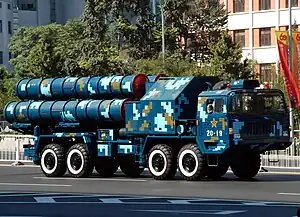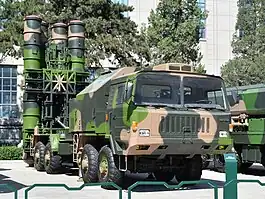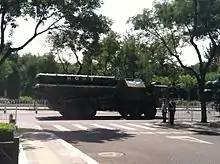| HQ-9 | |
|---|---|
 An HQ-9 portable launcher during China's 60th anniversary parade in 2009, Beijing | |
| Type | Long-range surface-to-air missile Anti-satellite weapon Anti-ballistic missile |
| Place of origin | China |
| Service history | |
| In service | Pre-2001 – present[1] |
| Used by | See Operators |
| Production history | |
| Manufacturer | China Aerospace Science and Industry Corporation[2] |
| Specifications | |
Operational range | 120 km (HQ-9)[3] 250 km (HQ-9B)[4][5] |
| Flight ceiling | 50 km (HQ-9B)[5] |
| Maximum speed | Mach 4+[3] |
Guidance system | Semi-active radar homing[4] |
Launch platform | HQ-9 ground-launched[6] HHQ-9 surface-launched[3] |
The HQ-9 (simplified Chinese: 红旗-9; traditional Chinese: 紅旗-9; pinyin: Hóng Qí-9; lit. 'Red Banner-9') is a long-range semi-active radar homing (SARH) surface-to-air missile (SAM) developed by the People's Republic of China.[3][4] The naval variant is the HHQ-9 (simplified Chinese: 海红旗-9; traditional Chinese: 海紅旗-9; pinyin: Hǎi Hóng Qí-9; lit. 'Sea Red Banner-9').[3]
Description
The HQ-9 is a derivative of the Russian S-300.[3][4][7] Justin Bronk of the Royal United Services Institute describes the missile as a "hybrid design based on a Russian SA-20 but with radar, seeker head and C2 elements heavily influenced by American and Israeli technology."[7] Early HQ-9s may use track-via-missile guidance developed from a United States MIM-104 Patriot missile purchased from Israel or Germany.[6]
According to a 2001 article from Defence International, the HQ-9 is 6.8 m. long with a mass of nearly two tons. The diameters of the first and second stages are 700 mm and 560 mm, respectively. The warhead mass is 180 kg, and the maximum speed is Mach 4.2. The HQ-9 may use fire-control radars from other Chinese SAM systems.[8]

Variants

- Air defense
- HQ-9
%252C_Penang_Strait%252C_Penang.jpg.webp)
- HHQ-9 — Naval surface-launched variant.[3]
- HQ-9A — Improved version, first tested in 1999 and service entry in 2001.[1]
- HQ-9B — Improved version with 250 km range and added passive infrared seeker.[4] Reportedly tested in February 2006.[1]
- Ballistic missile defense and anti-satellite
- HQ-19 – Anti-ballistic missile variant, reportedly designed to counter medium-range ballistic missiles. It targets ballistic missiles in their midcourse and terminal phases, and it is comparable to the US THAAD.[9] The missile may have "begun preliminary operations" by 2018.[10]
- Export
- FD-2000 – Export variant with a range of 125 km.[6] May be fitted with YLC-20 passive radar against stealthy targets.[11] May use the HT-233 target-acquisition radar,[12] Type 120 low-altitude search radar, and Type 305A AESA search radar.[11]
- FD-2000B – Export variant with a range of 250 km.
- HQ-9/P – Custom variant for Pakistan. Range of over 100 km for interception against aircraft and around 25 km against cruise missiles.[13]
Foreign interest
Turkey
The HQ-9 was a contender in Turkey's T-LORAMIDS program, and it was reportedly selected as the winner in September 2013.[14] The United States responded by blocking funds to integrate the Chinese system into NATO defenses.[15] However, through 2013 there was no confirmation that the deal had been finalized.[16][17][18] In February 2015, the Grand National Assembly of Turkey was informed by the Ministry of National Defence that the evaluation of bids was complete and that the chosen system would be used by Turkey without integration with NATO; the system was not explicitly named. However, other Turkish officials reported that no winner had been selected.[19] Later in the month, Turkish officials revealed that negotiations were ongoing with multiple bidders; the Chinese bid had not yet satisfied requirements concerning technology transfer.[20] In March 2015, a China Daily article reported that it was "well-known that the Chinese FD-2000 system, a HQ-9 model for export, was chosen for the contract with Turkey in 2013" based on comments made by a CPMIEC representative at the 2015 Langkawi International Maritime and Aerospace Exhibition; the article was misleadingly called "Missile sale to Turkey confirmed."[21] In November 2015, Turkey confirmed it would not purchase the HQ-9, opting for an indigenously developed system instead.[22]
Operating history
China
In July 2015, the PLA deployed the HQ-9 close to Kashmir along the LAC in preparation for a potential territorial conflict with India. The air defense systems were sent to the Hetian airfield located south of the Xinjiang region, which is only 260 km away from the Kashmir region. According to Kanwa Defense Review, a Chinese-language magazine based in Canada, radar vehicles of HQ-9 air defense missiles have been spotted at the base and assessed that they are intended to defend China's western border from any potential air strikes launched by the Indian Air Force.[23]
On 17 February 2016, the Taiwan defense ministry said it had "learned of an air defence missile system deployed" by the Chinese on Woody Island in the Paracel Islands. It would not say how many missiles had been deployed or when, but told the BBC they would be capable of targeting civilian and military aircraft from Vietnam or the Philippines. The commander of the US Pacific Fleet confirmed the deployment to Reuters news agency. Adm Harry Harris said such a move would be "a militarisation of the South China Sea in ways" Chinese military chairman Xi Jinping had pledged not to make.
Deployment in South China Sea
Japanese Chief Cabinet Secretary Yoshihide Suga said there were "serious concerns" over China's "unilateral move to change the status quo" in the region, and "we cannot accept this fact." Satellite images show a close-up of a section of beach, the shape of which resembles the northern coastline of Woody/Yongxing Island in the Paracels as it appears on other images, and point out two missile batteries. Each battery is made up of four launchers and two control vehicles. Two of the launchers appear to have been erected, says the report. Fox News quoted a US defence official as saying the missiles appeared to be the HQ-9 air defence system, with a range of about 200 km (125 miles).[24][25]
Pakistan
The Pakistan Army operates the HQ-9/P variant.[13] Negotiations for the purchase of the HQ-9 and HQ-16 by Pakistan began in early 2015.[26] The missiles officially entered service on October 14, 2021.[13]
Operators
- People's Liberation Army Air Force[27] - 180 HQ-9, 80 HQ-9B as of 2020[28]
- People's Liberation Army Navy[29][30] - 16 HQ-9, 16 HQ-9B as of 2020[31] (land based launcher).
- Royal Moroccan Army - Four batteries of FD-2000B purchased in 2016. The first battery was expected to be delivered in 2020 or 2021.[32]
- Pakistan Army[13] - HQ-9P[35]
- Pakistan Air Force[36] - HQ-9B[35]
See also
- Similar systems
- Terminal High Altitude Area Defense (HQ-19, SC-19)
- MIM-104 Patriot
- S-300 (missile)
- Medium Extended Air Defense System
- XRSAM
- Aster
- David's Sling
- Related lists
References
Citations
- 1 2 3 "HQ-9/-15, and RF-9 (HHQ-9 and S-300) (China), Defensive weapons". Jane's Information Group. 7 January 2010. Archived from the original on 3 May 2012.
- ↑ Grevatt, Jon (11 February 2016). "China's CASIC targets international expansion". Janes. Retrieved 11 December 2021.
- 1 2 3 4 5 6 7 McCabe, Thomas R. (23 March 2020). "Air and Space Power with Chinese Characteristics: China's Military Revolution" (PDF). Air & Space Power Journal. 34 (1): 28. Retrieved 11 December 2021.
- 1 2 3 4 5 Dahm (March 2021): page 6
- 1 2 Chen, Chuanren (2 August 2017). "China Shows New Fighters, Missiles and Drones". AINonline. Retrieved 16 May 2022.
- 1 2 3 Fisher, Richard D Jr (11 February 2016). "China deploys HQ-9 surface-to-air missiles to Woody Island". Archived from the original on 20 February 2016. Retrieved 11 December 2021.
- 1 2 Bronk, Justin (January 2020). Modern Russian and Chinese Integrated Air Defence Systems: The Nature of the Threat, Growth Trajectory and Western Options (Report). Royal United Services Institute. p. 20. Retrieved 11 December 2021.
- ↑ 「黃河」 (January 2001). "巡天神箭 紅旗9號與紅旗家族動態". Defence International (114): 72–81.
- ↑ Saunders, Phillip C. (10 June 2021). "Testimony before the U.S.-China Economic and Security Review Commission Hearing on China's Nuclear Forces" (PDF). U.S.-China Economic and Security Review Commission. Retrieved 11 December 2021.
- ↑ United States Office of the Secretary of Defense (2018). Annual Report To Congress: Military and Security Developments Involving the People's Republic of China 2018 (PDF) (Report). p. 60. Retrieved 11 December 2021.
- 1 2 Hasik, James (2 October 2013). "Chinese Anti-Aircraft Missiles for Turkey? Some Implications for Security and Industry". Atlantic Council. Retrieved 11 December 2021.
- 1 2 Cranny-Evans, Samuel (22 November 2019). "Uzbekistan conducts first FD-2000 air-defence test". Janes. Retrieved 11 December 2021.
- 1 2 3 4 Cranny-Evans, Samuel; Dominguez, Gabriel (15 October 2021). "Pakistan Army commissions HQ-9/P air-defence system". Janes. Retrieved 11 December 2021.
- ↑ Toksabay, Ece (26 September 2013). "Chinese firm wins Turkey's missile defense system tender". reuters.com. reuters. Retrieved 26 September 2013.
- ↑ Wilson, Steve (14 December 2013). "Congress to block Turkey using US funds to buy missile system from blacklisted Chinese firm". telegraph.co.uk. AFP. Retrieved 14 December 2013.
- ↑ Lague, David (2 October 2013). "For China, Turkey missile deal a victory even if it doesn't happen". Reuters.
- ↑ Daloglu, Tulin (27 September 2013). "Turkey close to deal with China for anti-missile system". Al-Monitor.
- ↑ "Update: Turkey Remains Defiant About Co-Producing Missile Defense System with China". Defense Update. 25 October 2013.
- ↑ Karadeniz, Tulay (19 February 2015). "Turkey eyes deal with China on missile defense despite NATO concern". Reuters. Retrieved 12 May 2015.
- ↑ Coskun, Orhan; Karadeniz, Tulay (26 February 2015). "Turkey goes back to other missile system bidders as China drags feet: officials". Reuters. Retrieved 12 May 2015.
- ↑ Peng, Yining (19 March 2015). "Missile sale to Turkey confirmed". China Daily. Retrieved 12 May 2015.
- ↑ Butler, Daren; Karadeniz, Tulay; Martina, Michael (18 November 2015). Mark, Heinrich (ed.). "UPDATE 2-Turkey confirms cancellation of $3.4-bln missile defence project awarded to China". Reuters. Retrieved 25 November 2015.
- ↑ "PLA sends HQ-9 air defense missiles close to Kashmir border". Want China Times. 6 July 2015. Archived from the original on 6 October 2015. Retrieved 2 August 2015.
- ↑ "China 'has deployed missiles in South China Sea' - Taiwan". BBC News. 17 February 2016.
- ↑ "U.S. expects 'very serious' talks with China after missile reports". Reuters. 17 February 2016 – via www.reuters.com.
- ↑ "Pakistan first to China's table for HQ-9, HQ-16 missile systems". Want China Times. 2 April 2015. Archived from the original on 16 July 2015. Retrieved 2 August 2015.
- ↑ International Institute for Strategic Studies 2020, p. 265.
- ↑ The Military Balance 2021. International Institute for Strategic Studies. p. 255.
- ↑ International Institute for Strategic Studies 2020, p. 262.
- ↑ International Institute for Strategic Studies 2020, p. 263.
- ↑ The Military Balance 2021. International Institute for Strategic Studies. p. 254.
- ↑ Halimi, Mohammed (26 June 2020). "Marruecos a punto de recibir su primer sistema de defensa aérea de largo alcance". Defensa.com (in Spanish). Retrieved 26 June 2020.
- ↑ International Institute for Strategic Studies 2020, p. 211.
- ↑ International Institute for Strategic Studies 2020, p. 216.
- 1 2 "HQ-9 Long-Range Air Defense Missile System | MilitaryToday.com". www.militarytoday.com. Retrieved 29 August 2023.
- ↑ Hum Arze Pak Key Hawai Fauj K Uqaab, retrieved 11 March 2022
Sources
- Dahm, J. Michael (March 2021). Offensive and Defensive Strike (PDF) (Report). South China Sea Military Capabilities Series. Johns Hopkins University Applied Physics Laboratory. Retrieved 11 December 2021.
- International Institute for Strategic Studies (15 February 2020). The Military Balance 2020. London, England: Routledge. ISBN 978-0-367-46639-8.
External links
- HQ-9 missile launch photos, Chinese Air Force Archived 10 April 2016 at the Wayback Machine AirForceWorld.com
- FD-2000 long range air defense missile system(Army recognition)
- HQ-9 medium-to-long range air defense missile system(Army recognition)
- HQ-9 / FT-2000 SAM Sinodefence
- Naval HQ-9 SAM Sinodefence
- HQ-9 Missilethreat.com
- CHINA OFFERS FD-2000 / HQ-9, FK-1000 AND FL-3000N MISSILE SYSTEMS TO THAILAND 6 November 2013